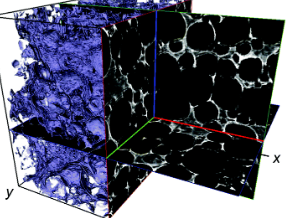Thermo Fisher Scientific › Electron Microscopy › Electron Microscopes › 3D Visualization, Analysis and EM Software › Use Case Gallery

Biodegradable materials, such as collagen scaffolds, are used extensively in clinical medicine for tissue regeneration and/or as an implantable drug delivery vehicle. However, available methods to study biomaterial degradation are typically invasive, destructive, and/or non-volumetric. Therefore, the objective of this study was to investigate a new method for nondestructive, longitudinal, and volumetric measurement of collagen scaffold degradation. Gold nanoparticles (Au NPs) were covalently conjugated to collagen fibrils during scaffold preparation to enable contrast-enhanced imaging of collagen scaffolds. The X-ray attenuation of as-prepared scaffolds increased linearly with increased Au NP concentration such that ≥60 mM Au NPs provided sufficient contrast to measure scaffold degradation. Collagen scaffold degradation kinetics were measured to increase during in vitro enzymatic degradation in media with an increased concentration of collagenase. The scaffold degradation kinetics measured by micro-CT exhibited lower variability compared with gravimetric measurement and were validated by measurement of the release of Au NPs from the same samples by optical spectroscopy. Thus, Au NPs and CT synergistically enabled nondestructive, longitudinal, and volumetric measurement of collagen scaffold degradation.
For Research Use Only. Not for use in diagnostic procedures.